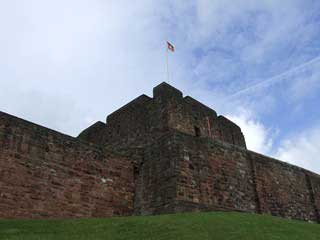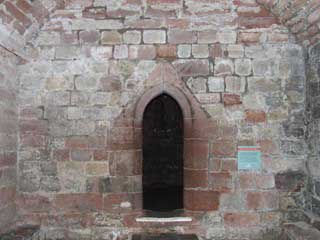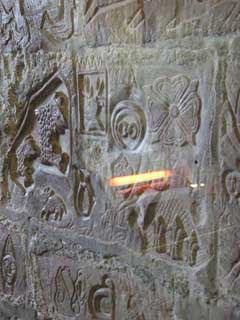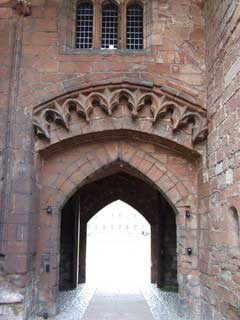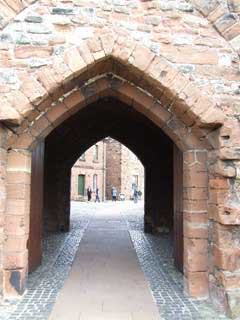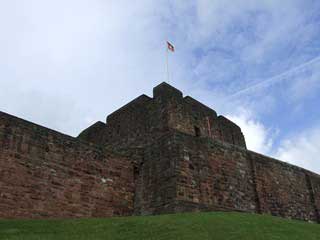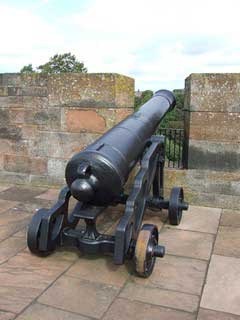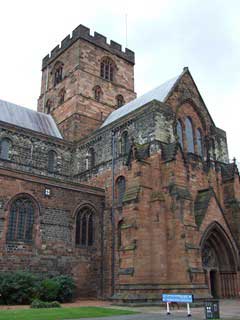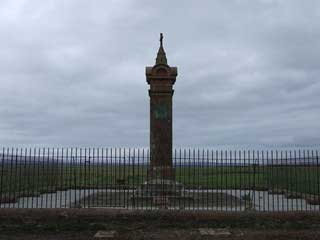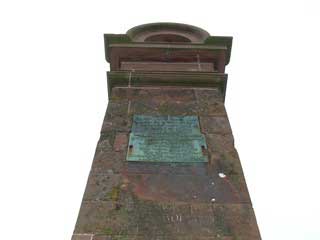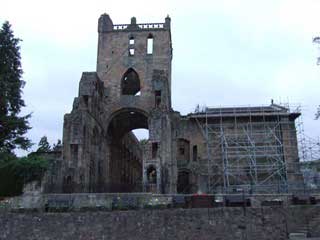
IN THE FOOTSTEPS OF DAVID R. ROSS "CARLISLE" |
I had been to Carlisle before but never got a chance to have a look at the castle itself where so much of Scotland's history is entangled. Once more with my trusty copy of DESIRE LINES under my arm, off I went to explore.
Situated less than ten miles from the Scottish border, it's not surprising that Carlisle Castle was subjected to a history of feuding and attack throughout the first 700 years of its construction.
Overlooking the River Eden in Cumbria, Carlisle Castle was built by William Rufus in 1092, after gaining control of the city that was dominated for the preceding 200 years by the Scots.
Despite the castle falling temporarily into Scottish possession during the Civil War and, later, the Jacobite Rising, Carlisle has remained 'English' more or less since the 12th century.
The oldest and most impressive surviving building is the large 12th century Norman Keep, built after the Norman conquest of England in 1066, situated at the north east corner of the Inner Bailey. This was the first stone building on the site, and served as the Royal Palace of David I. |
On the ground floor level, one of the more chilling legends is revealed in the "Licking Stones"apparently a room here was utilised as the dungeon during the Jacobite Rising and, suffering from a lack of water, the prisoners used to lick the stones in an effort to obtain sufficient moisture to stay alive! That was English justice for you.
I sat in this room for a while alone and felt uneasy, I've felt this way before at Culloden and St Bride's in Douglas.
At Prestonpans Bonnie Prince Charlie released his English prisoners unharmed, unlike the English who treated the Jacobites with intolerable cruelty after Culloden.
So many of my countrymen have entered this building never to return.
Robert the Bruce lost two brothers in this castle, Alexander and Thomas, Thomas' head was displayed atop this very keep you see today. |
Other buildings within the Inner Bailey include the Captain's Tower (or inner Gatehouse), a typical 12th century structure with heavy wooden doors, a portcullis and the gruesome 'murder holes'.
There are the fragmented remains of the Royal apartments, the chapel and the Great Hall, now overshadowed by the Museum of the King's Own Border Regiment and, perhaps most famously, the ruins of Queen Mary's Tower in the far north east corner. She was imprisoned within the castle in 1568. The tower is among the oldest buildings of Carlisle Castle, and was named after Mary Queen of Scots. Lady's Walk was similarly named, as this was the area where Mary used to walk in the sunshine during her captivity at Carlisle Castle.
There's also some wonderful stone carvings on the walls of one room, some say it was prisoners who did these, others say it was bored soldiers, I prefer the idea of condemned men carving their designs into the walls as a lasting memory to their captors cruelty.
|
Carlisle Castle was built to fulfil the need to keep the northern border of England secure against the threat of invasion from Scotland. In 1122, Henry I of England gave orders for the old Norman castle to be replaced by a stone castle and a stone keep and walls erected.
The Scots didn’t take to kindly to being evicted from their lands and over the next 700 years the city of Carlisle and its castle would be fought over, with its ownership changing hands many times through out the course of the centuries. The first attempt began during the troubled reign of Stephen of England.
The Scottish King, David captured the town, exploiting the domestic troubles of England. It was he who completed the walls and stone keep. However the English seized back the city and castle several years later.
|
Carlisle castle was again at the fore front of hostilities during the second Jacobite rising against George II of Great Britain in 1745. The forces of Prince Charles travelled south from Scotland, reaching as far as Derby.
Carlisle castle was overwhelmed and fortified by the Jacobites. This occupation didn’t last long and the Jacobites were driven north by William Augustus, Duke of Cumberland and the son of George II. Carlisle was recaptured and the Jacobites were jailed and executed.
This marked the end of the castle's fighting life, as defending the border between England and Scotland was not necessary as both countries were now one in "Great Britain." Some parts of the castle were then demolished for use as raw materials. |
I took a walk over to the Cathedral which is only a ten minute walk away. I have to say as far as Cathedrals go it was not my favourite, the ceiling was dark blue with gold stars looking down on you which was impressive.
I had gone to the Cathedral mainly because it was used as a prison for some of the Jacobites after Culloden and I just wanted to pay my respects.
I would have liked to have seen some kind of monument to the Jacobites and fellow Scots who died so horribly in this part of England, perhaps I ask for too much or perhaps the English would rather forget their cruelty to the Scots throughout history. Maybe they'd like us to forget as well, aye right!!! |
If you're in the area you must take a drive to see Longshank's memorial just north of Burgh by Sands on some grassland short of the Solway.
As you stand here you can see the hills of Scotland, so close Eddie, so close!!! He breathed his last on this very spot and I stood there knowing that this evil tyrant warmonger of a man never got to fulfil his dream of "cleansing" Scotland of the Scots, and I felt proud, very proud, to still be here, rejoicing in the resurgence of my countries nationalism and to never forget our countrymen who died so that we could still have a country of our own! Alba Gu Brath |
David R. Ross recommends a wee scenic drive home back into Scotland which I heartily endorse, a great wee drive alongside Hadrian's wall from Carlisle to Carter's Bar which eventually brings you over The Cheviot range of hills.
The views are simply stunning!!
We had time to visit Otterburn Battlefield and Jedburgh Abbey before daylight robbed us of anymore exploring. There is so much to see in this area that I think you'd need to plan a few days at least to explore.
We retired to a little Indian restaurant in Jedburgh called The Sunrise which I can't recommend highly enough, the food was wonderful, maybe not Scottish food but the waiter did have a braw Scottish accent!! |
Back to Top
© Paisley Tartan Army 2008-09 |

